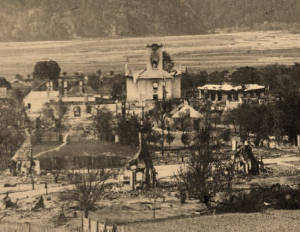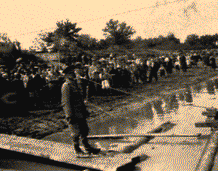|
Gura Humorului is a town located in north
Romania, Suceava County in southern Bukovina
(47◦25◦).
In those years Bukovina was the easternmost
crown land of the Austrian Empire and
covered an area of 10,422 square kilometers.
In the 1775 census of this province, its
population was only about 60,000
To encourage the development of this
sparsely-settled land, the Austrian emperors
subsidized the immigration of colonists to
Bukovina.
After end of these official immigration
programs, colonists would continue to arrive
at their own expense. As a result, by the
census of 1910, the population of Bukovina
had risen to over 800,000. People of many
different ethnic groups took part in this
immigration, including Germans Armenians,
Hungarians, Ukrainians, Poles, Romanians and
Jews.
In the beginning of the nineteenth century
there were no Jews in Gura Humorului.
The Jews begin to settle in Gura Humorului
around 1835 as well as other ethnic groups
(like the German Bohemian that emigrates
from the Bohemian Forest. Thirty families
settled on the mountainous virgin forest
land near Gurahumora, establishing the
village of Bori.)
The Jewish community began to flourish in
1869, then about third from Gura Humorului
inhabitants were Jews (880 souls). In that
year also the old "Beth Ha Midrash" was
established.

|
|
Gura Humorului after the great fire
of 1899 |
An important point mark in the history of
the town is the disastrous great fire of May
11, 1899 that turned almost all Gura
Humorului into ashes, destroying more than
400 houses including many businesses and
houses of Jews. The town was built up again
with the help of American-Jewish donations.
During World War I, Bukovina became a
battlefield between Austrian and Russian
troops. Although the Russians were finally
driven out in 1917, Austria would lose
Bukovina with the war, ceding the province
to Romania in the Treaty of St. Germain.
In spite of the war The Jewish community in
Gura Humorului continued to flourish
and in 1927 there were 1951 Jews there.
The Jews in Gura Humorului had a dynamic
Jewish life full of vitality. They spoke in
Yiddish alongside German and Romanian.
They had a traditional Jewish life. The
Jewish youngsters studied Torah along with
general subjects such as geography, History,
Mathematics and so on. The Jews established
a Jewish social and political institute, and
they took part in all life fields.
World War II - Transnistria
Transnistria is a region in the western
Ukraine, across the Dniestr River from
Romania that Hitler handed to Romania as a
reward for its participation in the war
against the Soviet Union. After it was
occupied, Transnistria became a
concentration ground for the Jews of
Bessarabia, Bukovina, and northern Moldavia,
whom the Romanian authorities deported on
the direct order of Ion Antonescu.
The deportations began on September 15,
1941, and continued on-and-off until the
autumn of 1942; September 15 is the official
date of the deportation of the Jews of
Bessarabia.
Gura
Humorului Jews deportation
Month later on
Friday, 10
October,
1941:
2945
Gura Humorului
Jews
went to bed in peace. Nothing unusual had
happened that day or in the past few days.
After midnight they were awakened by the
beating of drums in the streets. People went
outside, not knowing what was afoot. Jews
were told that they must be at the railway
station by 3 a.m. at the latest which meant
that they had two hours to put some bundles
together, lock up, and leave. At the station
they handed over their house keys and their
residency papers, and were given in exchange
a personal identification number. Then they
were put on a train. They did some of the
journey by train, the rest on foot, and
crossed the Dniester on boats.
Most of the deportations to Transnistria
took place on foot, via four transit points:
Atachi (the principal transit point),
Cosauti, Rezina, and Tiraspol. In all, an
estimated 150,000 persons were deported;
German sources speak of 185,000. In addition
to massacres carried out by Romanians, Jews
were murdered in the camps of Bogdanovka,
Akhmechetka and Domankevk.
|

|
|
Deportation of Romanian Jews to
Transnistria |
Survivors returned
On October 13, 1942, the Romanians called a
halt to the deportations to Transnistria
Finally, with the Soviet army closing in
on Transnistria, permission was given for
the Jews to come back, and in mid - December
1943 the first group of 1,500 survivors
returned. In March 1944 a group of 1,841
orphans, out of 4,500 still alive at the
time, came back. On March 15, the Soviet
army launched the liberation of
Transnistria. At this point a Jewish
committee from Bucharest succeeded in
repatriating another group, consisting of
2,518 deportees. Of the Jews who had been
deported to Transnistria, a total of 145,000
to 150,000, some 90,000 perished there. Many
of the remaining survivors were allowed to
return to Romania in 1945 and 1946.
Most of Gura Humorului Jews hed lose
their lives in Transnistria particular in
Mogilev Podolski, Bershad, Shargorod,
Obochov, Murafa and in Djurin.
Bukovina and Gura Humora Chronology
|
378 |
The battle between the Huns and the
Visigots in the area of Humor river
poured. |
|
1152-1187 |
Galicia was ruled by prince Iaroslav
Osmomysl (Yaroslav Os'momysl). He
expaneded the Galician principality
to the Danube.
|
|
1189 |
Hungarian king Bela III occupied
Galicia and became "King of
Halychyna".
|
|
1240 |
Bistrica Occupation by the
Mongol-Tatar.
|
|
1324 |
The Tartar invasion to Bukovina
regien.
|
|
1370-1387 |
Galicia ruled by Hungary.
|
|
1387-1772 |
Galicia ruled by Poland.
|
|
1412 |
Bukovina was first mentioned in an
agreement between King Ladislaus II
of Poland and Sigismund of Hungary.
|
|
1490-1775 |
Bukovina an integral part of the
Principality of Moldavia; under
local rulers but a tributary state
of the Ottoman Empire |
|
26.2.1490 |
The foundation of Gura Humora by
Stefan cel Mare. |
|
1514 |
Bukovina, became tributary to the
Turkish sultans. |
|
1538 |
Final transfer of Bukovyna/Bukowin
(former Galician Land) to Turkish
sovereingty |
|
1648-1652 |
The Cossacks invasion. |
|
1768-1774 |
Russo-Turkish War. |
|
1772 |
First partition of Poland by Russia,
Prussia, and Austria in which
Austria annexes Galicia |
|
1774 |
The annexation of "Austrian"
Moldavia, later called Bukovina by
Austria. |
|
1774 |
Major General Gabriel Baron von
Spleny serves as military governor
of "Austrian" Moldavia |
|
7.5.1775 |
Constantinopol contract. Austria
annexes Bukovina legaly.
|
|
1778 |
First census of Bukovina shows a
population of a little more than
100,000. |
|
1782-1787 |
German Protestants from the
Palatinate, Rhineland, and
Wurttemberg settle in
already-existing communities of
Arbora, Tereblestie, Illischestie,
Fratautz, Milleschoutz-Badeutz,
Satulmare, Molodia, Rosch, Zuczka,
Mitoka-Dragomirna, and Czernowitz
|
|
1784-1809 |
Germans from the Zips (Spiss in
today's Slovakia) brought to
Bukovina by Anton Manz |
|
1784-1849 |
Bukovina administratively was placed
under the Austrian province of
Galicia. |
|
1786 |
were leading some limitations on the
Jews as limitations of marriage
approval, Jewish property was banned
and atc. |
|
1787 |
Post office was opened in Gura
humora. |
|
1835 |
Telegram connection with Vienna.
|
|
1845 |
The start of the Jewish colonization
(3 families) |
|
1848-1849 |
Bukovina becomes an autonomous
crownland. |
|
1854 |
Floods in Gura Humora. |
|
1854 |
First telegraph service in
Czernowitz |
|
1857 |
Gura Humorului had a population of
2033 souls among them 190 Jews.
|
|
1859 |
Moldova and Wallachia unite and call
themselves Romania. |
|
1861 |
Bukovina is Autonomy. |
|
1866 |
Outbreaks of cholera in Bukovina
(About 50 people died in Gura
Humora). |
|
1866 |
Railroad
completed linking Lemberg (Lvov)
with Czernowitz. |
|
1867 |
Establishment of Dual Monarchy of
Austria-Hungary which lasts until
end of World War I, Gura Humorului
became a small market town.
|
|
1869 |
Austrian census reveals a population
in Bukovina of more than 500,000,
The first synagogue in Gura Humora
was erected. |
|
1871 |
The Great synagogue in Gura Humora
was erected. |
|
1877 |
Romania gains independence from the
Ottomans. |
|
1880 |
Gura Humorului got its own
independent Jewish cultural council.
|
|
1881 |
Kingdom of Romania declared, under
Carol Hohenzollern, the 1st.
|
|
1883 |
First telephone in Czernowitz
|
|
1886 |
Railroad line (Hatna-Kimpolung) ran
through Gura Humorului. |
|
1888 |
Floods. |
|
1897 |
Gura Humorului become to a county
city with 31 villages. |
|
11.5.1899 |
The town was burn almost absolutely.
|
|
1900 |
Sixty post offices in Bukovina
equipped with telegraph |
|
1904 |
Gura Humorului become to a town.
|
|
1914 |
Outbreak of World War I |
|
1915-1917 |
Intermittent Russian occupation of
Bukovina. |
|
1918 |
Romanian troops occupy Bukovina.
|
|
1919 |
Treaty of St. Germain by which
Bukovina passes to Romanian
administration |
|
1919-1923 |
Romanization of schools and civil
service; those not competent in
Romanian language are removed from
their positions; German National
Council works to promote and
safeguard German cultural interests.
|
|
1922-1926 |
The parliamentarian Constantin
Ardelianu is the mayor of Gura
Humorului. |
|
1925 |
Bukovina loses its provincial status
and autonomy,Gura Humorului status
as county city was canceled.
|
|
1930 |
Census in Bukovina shows 853,524
inhabitants |
|
1930-1939 |
Great Depression; high tariffs and a
policy of autarchy intensify
economic problems |
|
1940 |
Soviet annexation of Bessarabia and
northern Bukovina. |
|
9.10.1941 |
Jewish deportation from Bukovina to
Transnistria. |
|
7.4.1944 |
Difficult battles in Gura Humorului
until the start of September.
|
|
1941-1944 |
Germany attacks Soviet Union;
Bukovina reoccupied by German and
Romanian troops. |
|
5.1945 |
World War II ends in Europe. |
|
1947 |
Northern Bukovina, formally was
reannexed into the USSR / Ukrainian
SSR, Kingdom becomes Republic under
communistic regime. |
|
9.1947 |
The firs wave of immigration from
Gura Humorului to Israel, 140 Jews
left. |
|
23.12.1947 |
The second wave of immigration from
Gura Humorului to Israel, 160 Jews
left. |
|
1948-1951 |
The last wave of immigration from
Gura Humorului to Israel, Only a few
Jews remained behind. |
|
1967 |
Ceausescu becomes head of the state
- dictatorship. |
|
1989 |
Romania turns towards democracy and
capitalism, remains Republic,
Ceausescu overthrown. |
|
2001 |
Only 2 Jews remained in Gura
Humorului. |
|
06.2004 |
The last head of the Jewish
community in Gura Humorului was
demise, Only 1 Jew remained .
|
|


